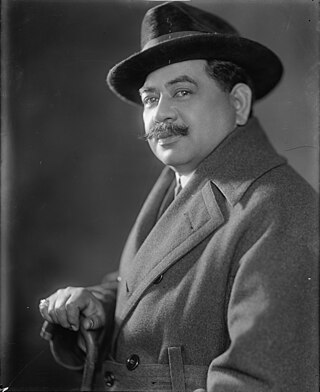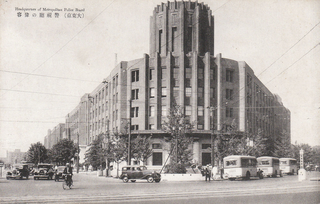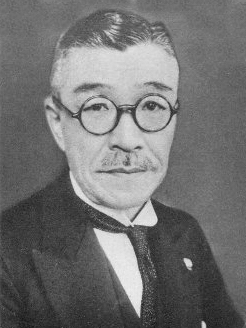Related Research Articles

The Tokugawa shogunate, also known as the Edo shogunate, was the military government of Japan during the Edo period from 1603 to 1868.
The history of Hawaii is the story of human settlements in the Hawaiian Islands beginning with their discovery and settlement by Polynesian people between 940 and 1200 AD.

The Peace Preservation Law was a Japanese law enacted on April 22, 1925, with the aim of allowing the Special Higher Police to more effectively suppress alleged socialists and communists. In addition to criminalizing forming an association with the aim of altering the kokutai of Japan, the law also explicitly criminalized criticism of the system of private property and became the centerpiece of a broad apparatus of thought control in Imperial Japan. Altogether, more than 70,000 people were arrested under the provisions of the law until its repeal by Allied occupation authorities at the end of World War II.

Jonah Kūhiō Kalanianaʻole was a prince of the Kingdom of Hawaiʻi until it was overthrown by a coalition of American and European businessmen in 1893. He later went on to become the delegate of the Territory of Hawaii to the United States Congress, and as such is the only royal-born member of Congress.

The Territory of Hawaii or Hawaii Territory was an organized incorporated territory of the United States that existed from April 30, 1900, until August 21, 1959, when most of its territory, excluding Palmyra Island, was admitted to the United States as the 50th US state, the State of Hawaii. The Hawaii Admission Act specified that the State of Hawaii would not include Palmyra Island, the Midway Islands, Kingman Reef, and Johnston Atoll, which includes Johnston Island and Sand Island.

Emma Kalanikaumakaʻamano Kaleleonālani Naʻea Rooke was queen of Hawaii as the wife of King Kamehameha IV from 1856 to his death in 1863. She was later a candidate for the throne but King Kalākaua was elected instead.

Censorship in the Empire of Japan was a continuation of a long tradition beginning in the feudal period of Japan. Government censorship of the press existed in Japan during the Edo period, as the Tokugawa bakufu was in many ways a police state, which sought to control the spread of information, including Christianity, the influx of Western ideas, pornography and any political writings critical of the shōgun and government.

The Special Higher Police, often abbreviated Tokkō, was, from 1911 to 1945, a Japanese policing organization, established within the Home Ministry for the purpose of carrying out high policing, domestic criminal investigations, and control of political groups and ideologies deemed to threaten the public order of the Empire of Japan. As the civilian counterpart to the military police forces of the Kenpeitai (army) and of the Tokkeitai (navy), the Tokkō's functions were criminal investigation and counter-espionage. The Tokubetsu Kōtō Keisatsu was also known by various nicknames such as the Peace Police and as the Thought Police.

The Police System of the Empire of Japan comprised numerous police services, in many cases with overlapping jurisdictions.

The Home Ministry was a Cabinet-level ministry established under the Meiji Constitution that managed the internal affairs of Empire of Japan from 1873 to 1947. Its duties included local administration, elections, police, monitoring people, social policy and public works. In 1938, the HM's social policy was detached from itself, then the Ministry of Health and Welfare was established. In 1947, the HM was abolished under the Supreme Commander for the Allied Powers restoration, then its administrative affairs were proceeded to the National Police Agency, the Ministry of Construction, the Ministry of Home Affairs and so on. In 2001, the MOHA was integrated with the Management and Coordination Agency and the Ministry of Posts and Telecommunications, then the Ministry of Public Management, Home affairs, Posts and Telecommunications was established. In 2004, the MPHPT changed its English name into the Ministry of Internal Affairs and Communications. In other words, the MIC is the direct descendant of the HM.

The overthrow of the Hawaiian Kingdom was a coup d'état against Queen Liliʻuokalani that took place on January 17, 1893, on the island of Oahu, and was led by the Committee of Safety, composed of seven foreign residents and six Hawaiian Kingdom subjects of American descent in Honolulu. The Committee prevailed upon American minister John L. Stevens to call in the US Marines to protect the national interest of the United States of America. The insurgents established the Republic of Hawaii, but their ultimate goal was the annexation of the islands to the United States, which occurred in 1898.

Count Makino Nobuaki, also Makino Shinken, was a Japanese politician and imperial court official. As Lord Keeper of the Privy Seal of Japan, Makino served as Emperor Hirohito's chief counselor on the monarch's position in Japanese society and policymaking.

Kamigamo Shrine is an important Shinto sanctuary on the banks of the Kamo River in north Kyoto, first founded in 678. Its formal name is the Kamo-wakeikazuchi Shrine.
Tenkō is a Japanese term referring to the coerced ideological conversions of Japanese socialists and communists who, between 1925 and 1945, were induced to renounce leftist ideologies and enthusiastically embrace the Emperor-centric, capitalist, and imperialist ideology favored by the state. Tenkō was typically performed under duress, most often in police custody, and was a condition for release. But it was also a broader phenomenon, a kind of cultural reorientation in the face of national crisis, that did not always involve direct repression.
Herbert Paul Varley was an American academic, historian, author, and Japanologist. He was an emeritus professor at Columbia University and Sen Sōshitsu XV Professor of Japanese Cultural History at the University of Hawaii.

The Hawaii Democratic Revolution of 1954 is a popular term for the territorial elections of 1954 in which the long dominance of the Hawaii Republican Party in the legislature came to an abrupt end, replaced by the Democratic Party of Hawaii which has remained dominant since. The shift was preceded by general strikes, protests, and other acts of civil disobedience that took place in the Hawaiian Archipelago. The strikes by the Isles' labor workers demanded similar pay and benefits to their Mainland counterparts. The strikes also crippled the power of the sugarcane plantations and the Big Five Oligopoly over their workers.

Suehiko Shiono was a Japanese lawyer, politician and cabinet minister noted for his prosecution of high-profile cases of political crimes and thought crimes under the Peace Preservation Laws of the 1930s Empire of Japan.
The Religious Organizations Law was a Japanese law passed by the National Diet in 1939 and enacted in 1940. The law gave the state authority control over religious organizations. Following Japan's defeat in World War II, the Religious Organizations Law was repealed on December 28, 1945, and replaced by the "Religious Corporations Ordinance".

Political prisoners in Imperial Japan were detained and prosecuted by the government of the Empire of Japan for dissent, attempting to change the national character of Japan, Communist activity, or association with a group whose stated aims included the aforementioned goals. Following the dissolution of the Empire of Japan after World War II, all remaining political prisoners were released by policies issued under the Allied occupation of Japan.
The Red Scare in Japan refers to the promotion of fear of the rise of communism and socialism in Japan.
References
- ↑ Tipton 1990, pp. 18–73.
- ↑ Tipton 1990, p. 45.